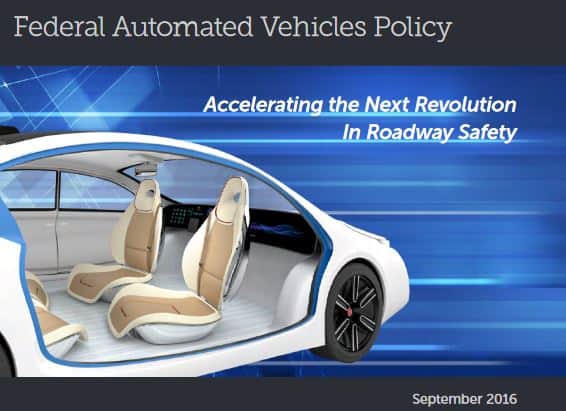 The U.S. Department of Transportation and NHTSA announced their guidelines for self-driving cars.
The U.S. Department of Transportation and NHTSA announced their guidelines for self-driving cars.
The policy sets a proactive approach to providing safety assurance and facilitating innovation through four key parts. Vehicle performance guidance uses a 15-point Safety Assessment to set clear expectations for manufacturers developing and deploying automated vehicle technologies. Model state policy delineates the Federal and State roles for the regulation of highly automated vehicle technologies as part of an effort to build a consistent national framework of laws to govern self-driving vehicles.
The policy also outlines options for the further use of current federal authorities to expedite the safe introduction of highly automated vehicles into the marketplace, as well as discusses new tools and authorities the federal government may need as the technology evolves and is deployed more widely.
The Federal Automated Vehicle Policy released used public input and stakeholder discussions, including two open public meetings this year and an open public docket for comments. The Department is also soliciting additional public comments for the next 60 days on the policy, which is published at www.transportation.gov/AV. Through a series of next steps and in response to public comments, DOT intends to update the policy annually.
The Obama Administration appears to have heeded many concerns raised by safety advocates in its new self-driving automated vehicle policy released today, Consumer Watchdog said. However, Consumer Watchdog added that it is studying the model state policy and that there are concerns about possible pre-emption of strong state regulations like those in California.
Details of Policy:
- 15 Point Safety Assessment –The Vehicle Performance Guidance for Automated Vehicles for manufacturers, developers and other organizations includes a 15 point “Safety Assessment” for the safe design, development, testing and deployment of automated vehicles.
- Model State Policy – This section presents a clear distinction between Federal and State responsibilities for regulation of highly automated vehicles, and suggests recommended policy areas for states to consider with a goal of generating a consistent national framework for the testing and deployment of highly automated vehicles.
- NHTSA’s Current Regulatory Tools – This discussion outlines NHTSA’s current regulatory tools that can be used to ensure the safe development of new technologies, such as interpreting current rules to allow for greater flexibility in design and providing limited exemptions to allow for testing of nontraditional vehicle designs in a more timely fashion.
- Modern Regulatory Tools – This discussion identifies new regulatory tools and statutory authorities that policymakers may consider in the future to aid the safe and efficient deployment of new lifesaving technologies.
The primary focus of the policy is on highly automated vehicles, or those in which the vehicle can take full control of the driving task in at least some circumstances. Portions of the policy also apply to lower levels of automation, including some of the driver-assistance systems already being deployed by automakers today.
Simultaneously with this policy, NHTSA is releasing a final enforcement guidance bulletin clarifying how its recall authority will apply to automated vehicle technologies. In particular, it emphasizes that semi-autonomous driving systems that fail to adequately account for the possibility that a distracted or inattentive driver-occupant might fail to retake control of the vehicle in a safety-critical situation may be defined as an unreasonable risk to safety and subject to recall.
Consumer Watchdog said it was pleased that the National Highway Traffic Safety Administration stressed that it could remove unsafe automated vehicles from the road. NHTSA said that a technology that fails to recognize a driver might become distracted and not resume control in a safety critical situation could be defined as a safety risk and recalled.